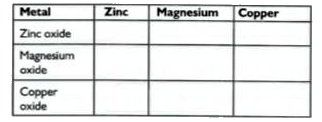Complete Solutions to QUESTIONS SECTION (IN-TEXT QUESTIONS) of chapter METALS AND NON METALS of Class 10 book with complete answers and questions
| Class 10 | CHEMISTRY |
| Chapter | METALS AND NON METALS |
| ZEN PUBLICATION | QUESTIONS SECTION (IN-TEXT QUESTIONS) |
| Number Of Questions | 15 |
| Academic Year | 2023-24 |
Give an example of a metal which
(i) is a liquid at room temperature.
(ii) can be easily cut with a knife.
(iii) is the best conductor of heat.
(iv) is a poor conductor of heat.
View SolutionExplain the meanings of malleable and ductile.
View SolutionWhy is sodium kept immersed in kerosene oil ?
View SolutionWrite equations for the reactions.
(i) Iron with steam
(ii) Calcium and potassium with water
View SolutionSamples of four metals A, B, C and D were taken and added to the following solutions one by one. The results obtained have been tabulated as follows :

Use the table given above to answer the following questions about metals A, B, C and D.
(i) Which is the most reactive metal ?
(ii) Arrange the metals A, B, C and D in the order of decreasing reactivity.
View SolutionWhich gas in produced when dilute hydrochloric acid as added to reactive metal ? Write the chemical reaction when iron reacts with dilute `H_(2)SO_(4)`.
View SolutionWhat would you observe when zinc is added to a solution of iron (II) sulphate ? Write the chemical reaction that take place
View Solution(i) Write the electron dot structure for sodium, oxygen and magnesium.
(ii) Show the formation of `Na_(2)O` and `MgO` by the transfer of electrons.
(iii) What are the ions present in these compounds.
View SolutionWhy do ionic compounds have high melting point ?
View SolutionDefine the following terms.
(i) Mineral (ii) ore (iii) Gangue
View SolutionName two metals which are found in nature in a free state.
View SolutionWhat chemical process is used for obtaining a metal from its oxide ?
View SolutionMetallic oxides of zinc, magnesium, and copper were heated with the following metals. In which cases do you find displacement reactions taking place?

View SolutionWhich metals do not corrode easily ?
View SolutionWhat are alloys ?
View Solution
QUESTIONS SECTION (IN-TEXT QUESTIONS) questions and complete solutions for chapter METALS AND NON METALS of ZEN CHEMISTRY (KANNADA ENGLISH) of Class 10
All Exercises from ZEN PUBLICATION Class 10 CHEMISTRY METALS AND NON METALS
- QUESTIONS SECTION (IN-TEXT QUESTIONS)
- QUESTIONS SECTION (TEXTUAL EXERSCISE)
- ZEN ADDITIONAL QUESTIONS SECTION (LONG ANSWER [LA] TYPE 2 QUESTIONS)
- ZEN ADDITIONAL QUESTIONS SECTION (MULTIPLE CHOICE QUESTIONS)
- ZEN ADDITIONAL QUESTIONS SECTION (SHORT ANSWER TYPE 2 QUESTIONS)
- ZEN ADDITIONAL QUESTIONS SECTION (SHORT ANSWER [SA] TYPE 1 QUESTIONS)
- ZEN ADDITIONAL QUESTIONS SECTION (VERY SHORT ANSWER [VSA] TYPE QUESTIONS)